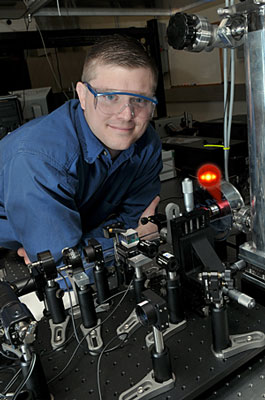| Posted: February 19, 2009 |
NSF grants Career Award for work on quantum dots |
|
(Nanowerk News) Matthew Doty, assistant professor in the Department of Materials Science and Engineering at the University of Delaware, has received a National Science Foundation Faculty Early Career Development Award for his work on quantum dot molecules.
|
|
The highly competitive NSF Career Award is bestowed on researchers deemed most likely to become the academic leaders of the 21st century.
|
|
The five-year $525,000 award will support not only Doty's research but also hands-on research and curriculum development for K-12 teachers, hands-on exploratory science experiences for K-12 students, and the development of interdisciplinary courses on nanoscale materials for advanced undergraduate students.
|
 |
| UD's Matthew Doty has won a prestigious NSF Career Award for his work in quantum dot molecules.
|
| Doty explains that quantum dots (QDs) are often referred to as “artificial atoms” because, like natural atoms, they have bound, discrete electronic states. Recent advances in materials science and nanofabrication techniques have made it possible to controllably couple individual QDs to create artificial molecules.
|
|
In contrast to natural molecules, however, where the degree of coupling is determined by the electro-negativity of each atom and the spacing between the atoms, in QD molecules (QDMs), the coupling can be engineered.
|
|
“This control over quantum mechanical coupling at the level of single electrons and holes opens the door for design of novel materials with revolutionary properties,” Doty says.
|
|
The applications for this technology include optoelectronic devices such as lasers and sensors, quantum information processing and functional materials.
|
|
“For QDMs to be of use in future technologies,” Doty says, “we have to understand the signatures and mechanisms of quantum mechanical coupling. This will require identifying their unique properties at the single molecule level while also figuring out how to scale the process up to increase the size of QDM assemblies.”
|
|
“Progress towards any of these possible applications requires answers to many fundamental questions about the coupling between quantum dots,” he adds. “What are the physical mechanisms of coupling? Do particles tunnel between dots or transfer via resonant energy transfer? How do the mechanisms of coupling depend on the material composition of the dots, their spatial separation, their energy levels, or the scaffold that connects the dots? What are the dynamics of interactions between electrons? How can we tune the degree of coupling in situ to create active materials?”
|
|
He hopes that his research over the next five years will yield answers to some of those questions.
|
|
As a part of the NSF Career program, Doty will host two high school teachers in his lab each summer, in an expansion of UD's ongoing Research Experiences for Teachers (RET) Nature InSpired Engineering (NISE) Program.
|
|
He also intends to create a portable experiment demonstrating the application of spectroscopy to materials characterization that teachers can borrow for use in their classrooms.
|
|
“In the long term,” Doty says, “I'd like to build a library of these types of modules to serve as a resource for middle- and high-school teachers.”
|
|
Doty joined the UD faculty in 2007 after a three-year stint as a National Research Council research associate at the Naval Research Laboratory. He earned his Ph.D. in physics at the University of California Santa Barbara.
|
|
“All of my degrees are in physics, and at the Navy Lab, I worked mostly with physicists and chemists,” he says. “The work there was much more basic than most engineering research. But the materials science department here at UD has turned out to be a really good fit for me. If I had joined a physics department, I wouldn't be right down the hall from people doing research on topics like recombinant DNA, organic solar cells, and self-assembly of biological materials. There's a real melding of expertise here that offers a great opportunity to look at problems from many different angles and come up with creative solutions. That's been really exciting for me.”
|
|
Although the prestigious NSF Career Awards are granted to help young investigators launch their independent research careers, Doty anticipates collaborating with colleagues both here at UD and at other institutions to explore various applications of his work. “You can't do science today by yourself,” he says.
|

